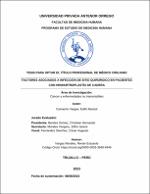Mostrar el registro sencillo del ítem
Factores asociados a infección de sitio quirúrgico en pacientes con Hemiartroplastía de cadera
| dc.contributor.advisor | Vargas Morales, Renán Estuardo | |
| dc.contributor.author | Camacho Vargas, Edith Marisol | |
| dc.creator | Camacho Vargas, Edith Marisol | |
| dc.date.accessioned | 2023-08-18T17:04:01Z | |
| dc.date.available | 2023-08-18T17:04:01Z | |
| dc.date.issued | 2023 | |
| dc.identifier.uri | https://hdl.handle.net/20.500.12759/11032 | |
| dc.description.abstract | Establecer los factores de riesgo y un modelo predictivo para infección de sitio quirúrgico (ISQ) en pacientes sometidos a hemiartroplastía de cadera. Material y métodos: Estudio observacional, retrospectivo y transversal realizado en el Hospital Víctor Lazarte Echegaray (HVLE) de Trujillo, donde se incluyeron pacientes sometidos a hemiartroplastía de cadera durante el periodo 2009 – 2019. De 318 expedientes médicos analizados, 243 cumplieron los criterios de inclusión. Se realizó un análisis bivariado utilizando las pruebas Chi-cuadrado y T de Student, considerándose significativo un valor de p < 0,05. Se ejecutó un análisis multivariado mediante regresión logística para identificar factores relacionados a ISQ. Asimismo, un modelo de predicción a través de la curva ROC. Resultados: Se identifican 22 ISQ, de tipo incisional superficial, lo que revela una prevalencia del 9,1%. En el análisis bivariado, la infección se asocia significativamente con la edad, nivel de instrucción, hipertensión arterial, enfermedad renal crónica, desnutrición, uso de drenaje, catéter urinario, transfusión sanguínea, estancia hospitalaria e índice NNIS ≥ 2, obteniendo valores de p < 0,05. Por otro lado, el análisis de regresión logística solo identifica al uso de drenaje (OR: 6,20; IC 95%: 1,25–30,85; p= 0,026), transfusión sanguínea (OR: 5,70; IC 95%: 1,35–24,00; p= 0,018), estancia hospitalaria (OR: 1,53; IC 95%: 1,18–2,00; p= 0,002) e índice NNIS ≥ 2 (OR: 34,52; IC 95%: 8,38–142,11; p < 0,001) como factores de riesgo independientes y significativos. El modelo predictivo para ISQ expuso un área bajo la curva de 0,955. Conclusiones: La ISQ en pacientes sometidos a hemiartroplastía de cadera se asocia con el uso de drenaje, transfusión sanguínea, estancia hospitalaria e índice de riesgo NNIS ≥ 2. Estas variables tienen una potencia de predicción del 95,5%. | es_PE |
| dc.description.abstract | To establish risk factors and a predictive model for surgical site infection (SSI) in patients undergoing hip hemiarthroplasty. Material and methods: Observational, retrospective and cross-sectional study conducted at Victor Lazarte Echegaray Hospital (HVLE) in Trujillo, which included patients who underwent hip hemiarthroplasty during the period 2009-2019. Of 318 medical records analysed, 243 met the inclusion criteria. A bivariate analysis was performed using the Chi-square and Student's T tests, considering a p value < 0,05 significant. A multivariate analysis was performed using logistic regression to identify factors related to SSI. Also, a prediction model through the ROC curve. Results: 22 SSIs are identified, of superficial incisional type, revealing a prevalence of 9,1%. In the bivariate analysis, infection is significantly associated with age, education level, arterial hypertension, chronic kidney disease, malnutrition, use of drainage, urinary catheter, blood transfusion, hospital stay, and NNIS index ≥ 2, obtaining values of p < 0,05. On the other hand, logistic regression analysis only identifies the use of drainage (OR: 6,20; 95% CI: 1,25 – 30,85; p = 0,026), blood transfusion (OR: 5,70; 95% CI: 1,35 – 24,00; p = 0,018), hospital stay (OR: 1,53; 95% CI: 1,18 – 2,00; p = 0,002) and NNIS index ≥ 2 (OR: 34,52; 95% CI: 8,38 – 142,11; p < 0,001) as independent and significant risk factors. The predictive model for SSI exposed an area under the curve of 0,955. Conclusions: SSI in patients undergoing hip hemiarthroplasty is associated with the use of drainage, blood transfusion, hospital stay, and NNIS risk index ≥ 2. These variables have a predictive power of 95.5%. | en_US |
| dc.description.uri | Tesis | es_PE |
| dc.format | application/pdf | es_PE |
| dc.language.iso | spa | es_PE |
| dc.publisher | Universidad Privada Antenor Orrego | es_PE |
| dc.relation.ispartofseries | T_MED_3540 | |
| dc.rights | info:eu-repo/semantics/openAccess | es_PE |
| dc.rights.uri | https://creativecommons.org/licenses/by/4.0/ | es_PE |
| dc.source | Universidad Privada Antenor Orrego | es_PE |
| dc.source | Repositorio institucional - UPAO | es_PE |
| dc.subject | Factor de Riesgo | es_PE |
| dc.subject | Infección de Sitio Quirúrgico | es_PE |
| dc.title | Factores asociados a infección de sitio quirúrgico en pacientes con Hemiartroplastía de cadera | es_PE |
| dc.type | info:eu-repo/semantics/bachelorThesis | es_PE |
| thesis.degree.grantor | Universidad Privada Antenor Orrego. Facultad de Medicina Humana | es_PE |
| thesis.degree.name | Medico Cirujano | es_PE |
| thesis.degree.discipline | Medicina | es_PE |
| dc.subject.ocde | http://purl.org/pe-repo/ocde/ford#3.02.27 | es_PE |
| renati.advisor.orcid | https://orcid.org/0000-0003-3948-4949 | es_PE |
| renati.author.dni | 76252595 | |
| renati.advisor.dni | 18139849 | |
| renati.type | http://purl.org/pe-repo/renati/type#tesis | es_PE |
| renati.level | http://purl.org/pe-repo/renati/level#tituloProfesional | es_PE |
| renati.discipline | 912016 | es_PE |
| renati.juror | Benites Gómez, Christian Hernando | |
| renati.juror | Morales Vergara, Joffre Jareck | |
| renati.juror | Fernández Sánchez, César Augusto | |
| dc.publisher.country | PE | es_PE |
Ficheros en el ítem
Este ítem aparece en la(s) siguiente(s) colección(es)
-
Medicina Humana [2774]




